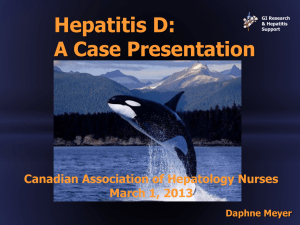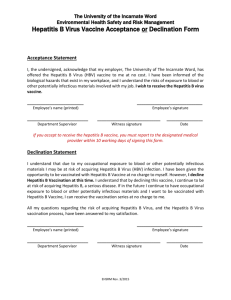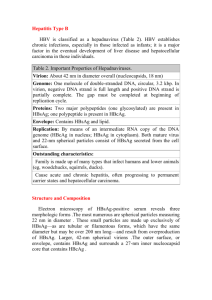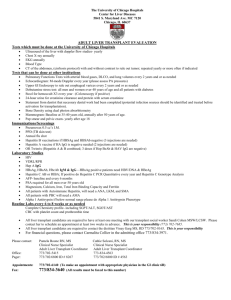Micro Objectives 26
advertisement
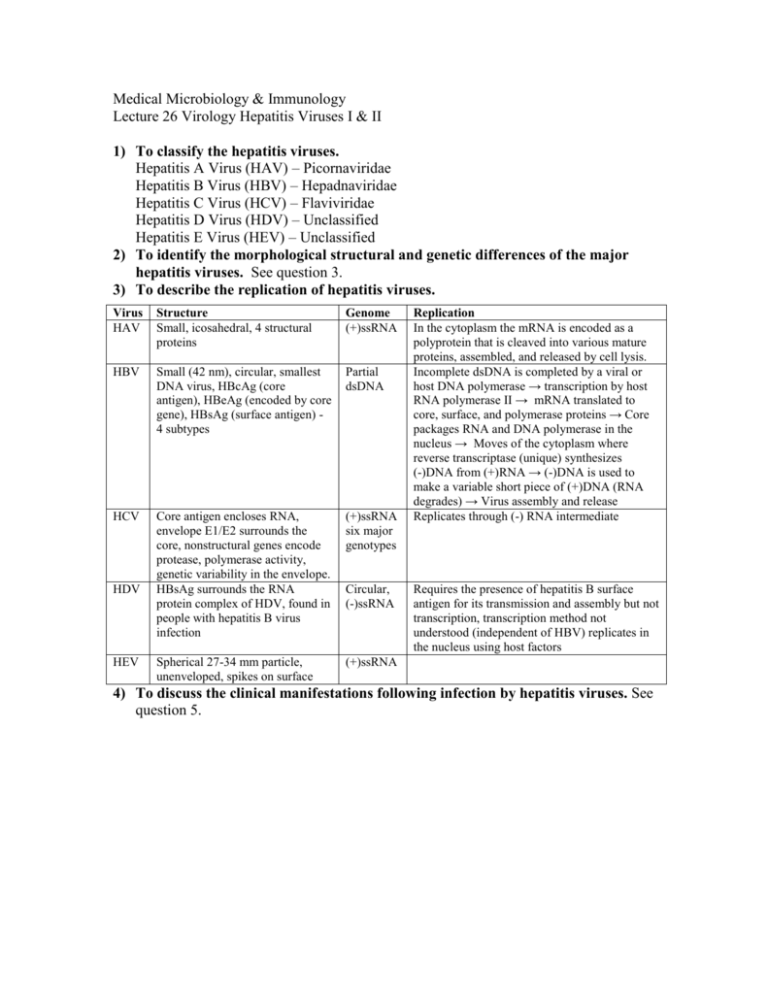
Medical Microbiology & Immunology Lecture 26 Virology Hepatitis Viruses I & II 1) To classify the hepatitis viruses. Hepatitis A Virus (HAV) – Picornaviridae Hepatitis B Virus (HBV) – Hepadnaviridae Hepatitis C Virus (HCV) – Flaviviridae Hepatitis D Virus (HDV) – Unclassified Hepatitis E Virus (HEV) – Unclassified 2) To identify the morphological structural and genetic differences of the major hepatitis viruses. See question 3. 3) To describe the replication of hepatitis viruses. Virus HAV Structure Small, icosahedral, 4 structural proteins Genome (+)ssRNA HBV Small (42 nm), circular, smallest DNA virus, HBcAg (core antigen), HBeAg (encoded by core gene), HBsAg (surface antigen) 4 subtypes Partial dsDNA HCV Core antigen encloses RNA, envelope E1/E2 surrounds the core, nonstructural genes encode protease, polymerase activity, genetic variability in the envelope. HBsAg surrounds the RNA protein complex of HDV, found in people with hepatitis B virus infection (+)ssRNA six major genotypes Spherical 27-34 mm particle, unenveloped, spikes on surface (+)ssRNA HDV HEV Circular, (-)ssRNA Replication In the cytoplasm the mRNA is encoded as a polyprotein that is cleaved into various mature proteins, assembled, and released by cell lysis. Incomplete dsDNA is completed by a viral or host DNA polymerase → transcription by host RNA polymerase II → mRNA translated to core, surface, and polymerase proteins → Core packages RNA and DNA polymerase in the nucleus → Moves of the cytoplasm where reverse transcriptase (unique) synthesizes (-)DNA from (+)RNA → (-)DNA is used to make a variable short piece of (+)DNA (RNA degrades) → Virus assembly and release Replicates through (-) RNA intermediate Requires the presence of hepatitis B surface antigen for its transmission and assembly but not transcription, transcription method not understood (independent of HBV) replicates in the nucleus using host factors 4) To discuss the clinical manifestations following infection by hepatitis viruses. See question 5. 5) To describe the diagnosis, treatment and prevention of hepatitis. Virus HAV HBV HCV HDV HEV Clinical disease Fecal oral transmission, shellfish, water. Mostly asymptomatic. Acute hepatitis: starts in intestine then moves to liver causing necrosis, sudden onset after 14-40 day incubation period fever, poor appetite, nausea, headache, malaise, vomiting, abdominal pain, and jaundice with dark urine, clay-colored stool, enlarged liver. In the is complete. Acute hepatitis B: similar to hepatitis A, longer incubation period (average 160 days), slow onset, transmission through body fluid (blood, saliva, semen, cervical secretions, blood products) Chronic hepatitis B: 10-20% of cases become chronic virus lives and replicates in the liver, HBsAg always present in serum, cirrhosis of the liver, hepatocellular carcinoma (200x increased risk) Transmitted by blood transfusions (no longer), sex (less than hep B), and needle sharing (40% of cases). Acute phase is mild, asymptomatic. Results in chronic disease (85%) leading to cirrhosis of liver and hepatocellular carcinoma (slow progression 1018 years). Leading cause of liver transplantation US. Simultaneous delta and hepatitis B infection resulting in cirrhosis of the liver, superinfection with chronic hepatitis B (accelerated), permanent hepatitis. Diagnosis Clinical picture, radio immunoassay kits are available to detect IgM antibody for HAV. Treatment and prevention Prevention: immune serum globulin administered before or during incubation period (household members and travelers going to endemic areas), inactivated hepatitis a virus vaccine. Demonstrate HBsAg in serum radioimmunoassay, complement fixation, or ELISA Treatment: interferon Prevention: hyperimmune globulin (passive), vaccines – HbsAg synthesized in yeast - 3 doses with 2nd dose 1 month after 1st and 3rd dose 6 months after 1st Elevated ALT, ELISA antibody detection, RIBA II test confirmation, PCR detection of RNA We need a vaccine. Development of several vaccines are underway Antibody to Delta PCR detection Transmitted through fecal-oral route. Causes acute disease like HAV. May fulminate especially in pregnant women. Most cases in India rarely US. Immunological assays Presence of specific IgM PCR Detection of RNA The surface protein of HDV is HBsAg and many measures aimed at limiting the transmission of HBV will prevent HDV transmission. No treatment is available Not known if immune serum globulin prevents infection


